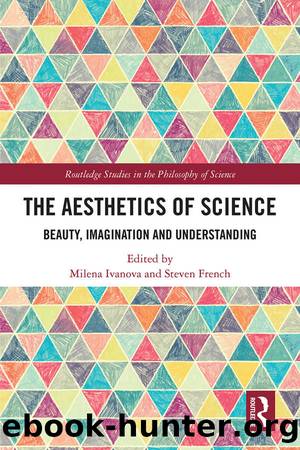The Aesthetics of Science (Routledge Studies in the Philosophy of Science) by Unknown

Author:Unknown
Language: eng
Format: epub
Publisher: amazon
3 Aesthetic Objects of Scientific Enquiry
The speed of light, the structure of DNA, the nature of gravity, mammalian evolution, mathematical constants, etc. are all objects of scientific enquiry diverging in scale and scope, but can we find a common denominator? More precisely, given our focus in the present context on the aesthetic dimension of science, could we say that science deals with objects qua bearers of aesthetic values? The idea might even be pushed further, and it might be suggested that scientific objects show aesthetic values and these very values capture the scientist’s attention leading her to study those objects. Scientists’ reports of their practice hint at such an idea. Aesthetic values such as harmony, regularity, coherence, unity and simplicity are often invoked by scientists as possessed by the objects under scrutiny and driving their enquiry. (As we have observed in the introduction, such values can also be instantiated, perhaps by inheritance, by the scientific constructions themselves, namely theories, hypotheses, models, etc.).
This is a vexed issue. Strong sceptics claim that when talking about aesthetic values scientists are not really referring to properties they are acquainted with, but rather merely employing metaphorical language. It would be a sort of confabulation, which hides other values or reasons (e.g., pragmatic or epistemic) behind aesthetic language. Leaving aside such a view and granting that scientific objects have aesthetic values, there is another pressing worry concerning what aesthetic values are relevant in the scientific domain. They might depend on the specific discipline. Physicists and mathematicians often praise aesthetic values like regularity and simplicity, but irregularity and complexity can also be seen as important aesthetic values shown by scientific objects. This is clearly seen if we turn, for instance, to biology (Ivanova 2017b), but even to specific branches of physics itself (e.g., Quantum Theory). Moreover, even within the same scientific discipline different levels of enquiry can show different aesthetic values. For instance, electricity might be seen as bearing different aesthetic values in different contexts (e.g., when conducting an experiment and when developing a theory).
To add a further layer of complexity, aside from the issue of scientific objects qua bearers of aesthetic values, we might ask whether in developing theories or studying phenomena scientists undergo aesthetic experiences. Again, scientists’ reports point in that direction. Albert Einstein, for instance, said that: “The fairest thing we can experience is the mysterious. It is the fundamental emotion that stands at the cradle of true art and true science” (Einstein 1934/1935: 5—see also Einstein 1932). Although Einstein is not explicitly talking about an aesthetic experience as such, he is referring to a kind of experience, which, in his view, is crucially involved in both art and science. Other scientists have compared the experience triggered by the confrontation with art to the experience triggered by the confrontation with science. To give an example, “Mathematics, rightly viewed, possesses not only truth, but supreme beauty”, wrote Bertrand Russell (Russell 1919: 60). The aside “rightly viewed” suggests that what matters is the perspective, the experience that the subject is undergoing in being confronted with mathematics.
Download
This site does not store any files on its server. We only index and link to content provided by other sites. Please contact the content providers to delete copyright contents if any and email us, we'll remove relevant links or contents immediately.
Kathy Andrews Collection by Kathy Andrews(11280)
The remains of the day by Kazuo Ishiguro(8341)
Paper Towns by Green John(4757)
Spare by Prince Harry The Duke of Sussex(4751)
The Body: A Guide for Occupants by Bill Bryson(4542)
Industrial Automation from Scratch: A hands-on guide to using sensors, actuators, PLCs, HMIs, and SCADA to automate industrial processes by Olushola Akande(4439)
Be in a Treehouse by Pete Nelson(3623)
Harry Potter and the Goblet Of Fire by J.K. Rowling(3583)
Never by Ken Follett(3490)
Machine Learning at Scale with H2O by Gregory Keys | David Whiting(3446)
Goodbye Paradise(3415)
Into Thin Air by Jon Krakauer(3102)
The Remains of the Day by Kazuo Ishiguro(3101)
The Cellar by Natasha Preston(3060)
The Genius of Japanese Carpentry by Azby Brown(3011)
Drawing Shortcuts: Developing Quick Drawing Skills Using Today's Technology by Leggitt Jim(2914)
120 Days of Sodom by Marquis de Sade(2910)
Fairy Tale by Stephen King(2858)
The Man Who Died Twice by Richard Osman(2779)
